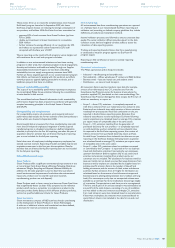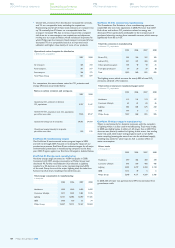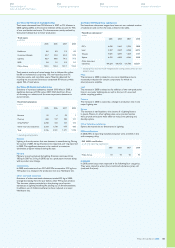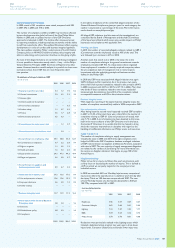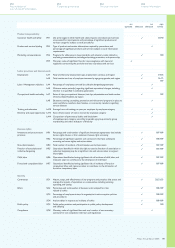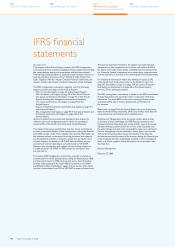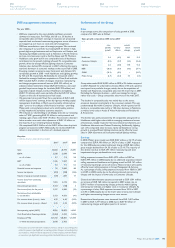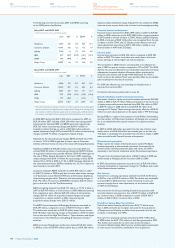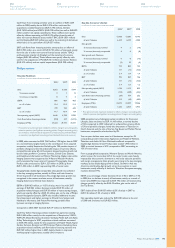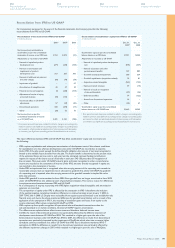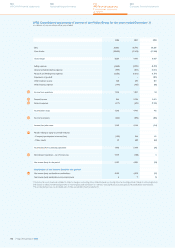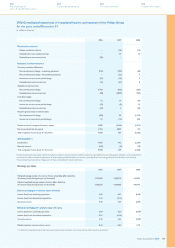Philips 2008 Annual Report Download - page 189
Download and view the complete annual report
Please find page 189 of the 2008 Philips annual report below. You can navigate through the pages in the report by either clicking on the pages listed below, or by using the keyword search tool below to find specific information within the annual report.
Supplier audit results
We implemented the EICC checklist for audits conducted in 2008.
This has led to a marked increase in the number of issues recorded.
Previously we focused primarily on social/labor-related issues, while
the checklist includes a broader range of parameters. Management
issues represent a major part of the increase in identified issues.
Findings identified during initial audits provide the base for the yearly
issue overview, and continual conformance audit findings have also
been included for the first time.
The vast majority of non-compliances (89%) were found in China.
The most frequently identified issues coming out of the 277 initial
and continual conformance audits were as follows:
Zero-tolerance – emergency preparedness (blocked fire exits);
•
occupational safety (immediate threat to health and safety);
working conditions (exposure to hazardous substances);
working hours (continual seven-day work weeks); and lack of
environmental permits.
Limited-tolerance – improper handling/processing of chemical •
waste; working hours (above legal limits/60 hours a week);
wages and benefits (below minimum wages and absence of legal
overtime payment); environmental performance objectives do not
meet legal requirements; lack of industrial hygiene (lack of personal
protective equipment); occupational injury and illness (no medical
treatment facility).
Increased speed in resolving zero-tolerance issues
At the Supply Leadership Meeting (a forum of the top 100 Philips
supply managers) in May 2008 we focused on resolving zero-tolerance
issues, leading to a breakthrough in resolution time. During the last
four months of the year all zero-tolerance issues were solved within
105 days, down significantly from the average resolution time of
250 days in 2007. This represents a 60% increase in speed of resolution.
At year-end there were no zero-tolerance issues older than three
months, indicating that ownership within the Philips Supply Management
community is now well engrained. Those remaining issues were
identified during audits performed in November and December 2008.
Where no improvement could be established, 25 suppliers were
phased out.
Tackling the most frequent zero-tolerances
The most frequently identified zero-tolerance issues related to
occupational health and safety risks and continual seven-day work
weeks. Health and safety issues can be resolved quickly, while dealing
with working hours often entails installing extra shifts with additional
personnel, which can take at least a month.
By helping our suppliers to see this as a business opportunity, more
than 30,000 workers from our supply base average at least one day
rest every week.
Resolving limited-tolerance issues
The top three open items for limited-tolerance concerns are the lack
of management systems to track and trace site environmental
pollution; environmental permits; reliable recording of working hours.
Some dated back to 2007 due to long lead time for implementing
required changes.
Independent assurance report
To the Supervisory Board and Shareholders of Koninklijke Philips
Electronics N.V.:
Introduction
We have been engaged by Koninklijke Philips Electronics N.V. to provide
limited assurance on the section Sustainability performance in this
Annual Report. The Board of Management is responsible for the
preparation and fair presentation of the Sustainability performance
section. Our responsibility is to provide limited assurance on this
information contained in this Annual Report.
Scope
Our engagement was designed to provide limited assurance on
whether the information in the section Sustainability performance
on pages 180 to 189 of this Annual Report is fairly stated.
Procedures performed to obtain a limited level of assurance are
aimed at determining the plausibility of data and are less extensive
than those for a reasonable level of assurance. Our procedures
included reviewing systems and processes for data management,
assessing the appropriateness of the accounting policies used,
assessing the data collection and reporting process at a limited
number of sites and evaluating the overall presentation of
sustainability information within our scope.
We have also reviewed, to the extent of our competence, whether
the section Sustainability on pages 62 to 67 is consistent with the
information in the section Sustainability performance.
Reporting criteria
There are no generally accepted standards for reporting sustainability
performance. Koninklijke Philips Electronics N.V. applies
the Sustainability
Reporting Guidelines of the Global Reporting Initiative (G3) together
with internal corporate guidelines, as detailed in Approach to
sustainability reporting in the section Sustainability performance on
pages 180 to 182. It is important to view the performance data in the
context of this explanatory information. We believe that these criteria
are suitable in view of the purpose of our assurance engagement.
Standards
We conducted our engagement in accordance with the International
Standard for Assurance Engagements (ISAE) 3000: Assurance
Engagements other than Audits or Reviews of Historical Financial
Information, issued by the International Auditing and Assurance
Standards Board. Amongst others, this standard requires that the
assurance team members possess the specific knowledge, skills and
professional competencies needed to understand and review the
information and that they comply with ethical requirements.
Conclusion
Based on our work described in this report, the information in the
section Sustainability performance on pages 180 to 189 does not appear
to be unfairly stated in accordance with the criteria described in
Approach to sustainability reporting in the section Sustainability
performance in this Annual Report.
We also report, to the extent of our competence, that the section
Sustainability on pages 62 to 67 is consistent with the section
Sustainability performance.
Amsterdam, 23 February 2009
KPMG Accountants N.V.
M.A. Soeting RA
Philips Annual Report 2008 189
254
Corporate governance
250
Reconciliation of
non-US GAAP information
262
Ten-year overview
266
Investor information




